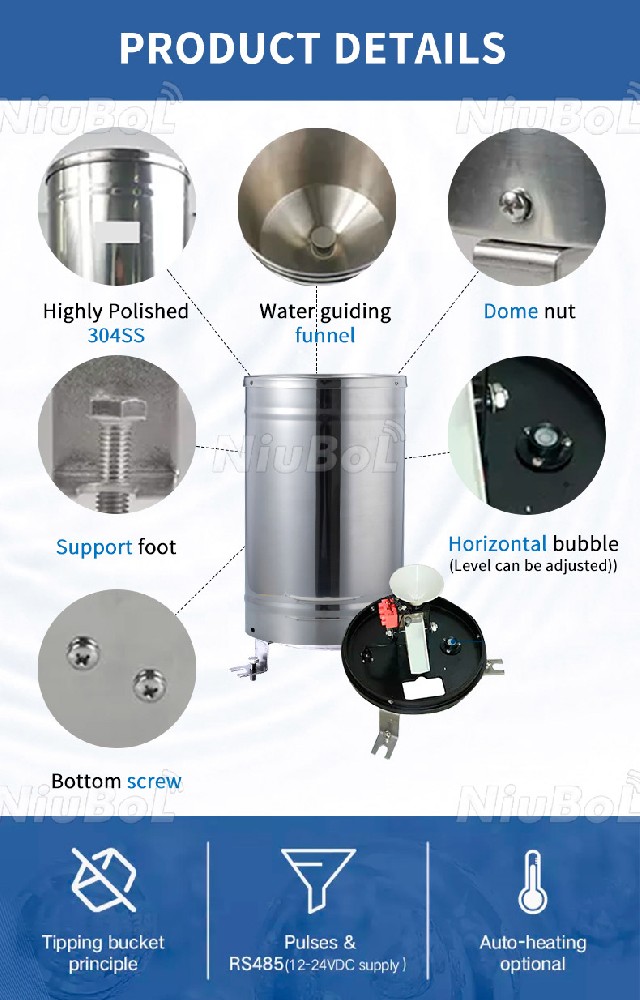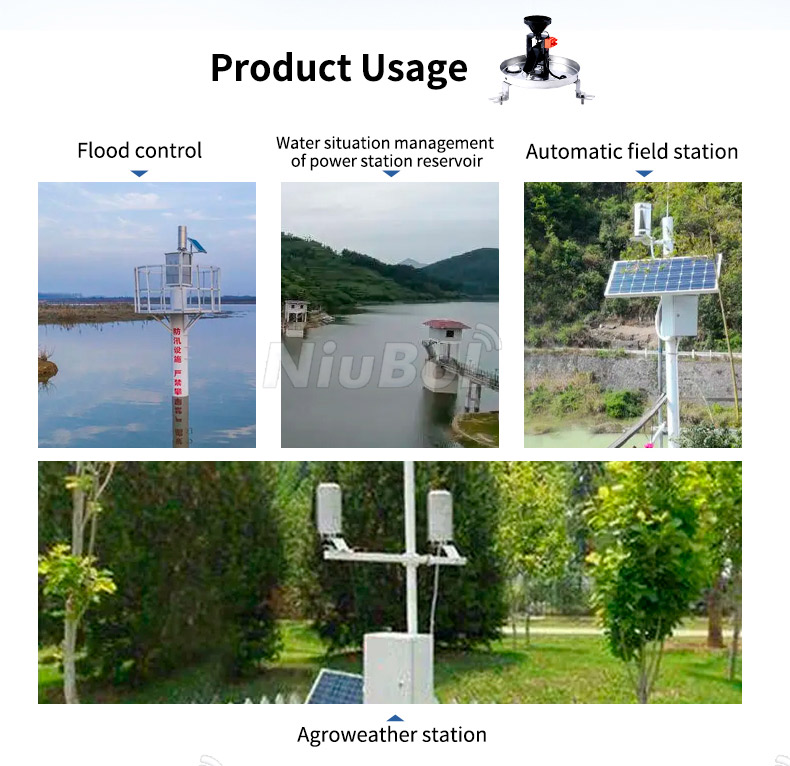

— Blogs —
—Products—
 Consumer hotline +8618073152920
Consumer hotline +8618073152920 WhatsApp:+8615367865107
Address:Room 102, District D, Houhu Industrial Park, Yuelu District, Changsha City, Hunan Province, China
Technical Support
Time:2023-09-07 15:24:57 Popularity:2845
Tipping Bucket Rain Gauge Introduction:
A tipping bucket rain gauge is a device that measures rainfall by using a tipping bucket mechanism. When the bucket tips, a mechanical or electrical switch is activated, automatically starting or emptying a timer. Rain gauges of this type are commonly used in meteorology and agriculture to measure and record rainfall data.
Tipping bucket rain gauges are widely used instruments for measuring rainfall in various applications. In this article, we will explore the common failures that can occur with tipping bucket rain gauges, provide maintenance tips to keep them in good working condition, and discuss the installation requirements for optimal performance.
Part 1: Common Failures of Tipping Bucket Rain Gauges
While tipping bucket rain gauges are reliable instruments, they can experience a few common failures. Some of these include:
1. Bucket Blockage: Debris such as leaves, branches, or insects may accumulate in the tipping buckets, preventing them from freely tipping. This can lead to inaccurate rainfall measurements or complete malfunction.
2. Misalignment: Improper alignment of the tipping bucket mechanism or the collector funnel can result in incorrect measurements. Misalignment can occur due to wear and tear or rough handling during transportation or installation.
3. Electrical Malfunction: If your tipping bucket rain gauge has additional features like data logging or wireless connectivity, there is a possibility of electrical malfunctions. This can be caused by power surges, water damage, or faulty wiring.
Part 2: Maintenance Tips for Tipping Bucket Rain Gauges
Regular maintenance can help prevent failures and ensure accurate measurements. Here are some maintenance tips for tipping bucket rain gauges:
1. Clean the Buckets: Inspect and clean the tipping buckets regularly to remove any debris or blockages. Use a soft brush or compressed air to clear out obstructions, ensuring smooth tipping action.
2. Check Alignment: Verify that the tipping bucket mechanism and collector funnel are properly aligned. Adjust and tighten any loose components to maintain accurate measurements.
3. Calibration: Periodically calibrate your tipping bucket rain gauge to confirm its measurement accuracy. Follow the manufacturer's guidelines for calibration procedures or consult professional weather instrument technicians.
4. Lubrication: Apply a small amount of silicone or lithium-based grease to the moving parts of the tipping bucket mechanism. This helps reduce friction and ensures smooth operation.
5. Protection from Extreme Weather: Protect your rain gauge from extreme weather conditions, such as heavy snowfall, strong winds, or intense sunlight. Consider using accessories like a shield or heating element to prevent ice or snow buildup.

Part 3: Installation Requirements for Tipping Bucket Rain Gauges
Proper installation is crucial for accurate measurements and longevity of the rain gauge. Consider the following requirements:
1. Level Surface: Install the rain gauge on a level surface, free from obstructions that may interfere with rainfall collection.
2. Height and Clearance: Place the collector funnel at an appropriate height above the ground, typically around 1.2 to 1.5 meters. Ensure there is sufficient clearance around the rain gauge to prevent interference from nearby structures or vegetation.
3. Stable Mounting: Use a stable mounting stand or bracket to secure the rain gauge firmly in place. Avoid installations in areas prone to excessive vibrations or movement.
4. Proper Orientation: Orient the collector opening of the rain gauge facing directly upwards to collect rainfall accurately. Align the tipping bucket mechanism parallel to the ground.

Conclusion:
Tipping bucket rain gauges can experience common failures such as bucket blockage, misalignment, and electrical malfunctions. Regular maintenance, including cleaning, alignment checks, calibration, and protection from extreme weather, can help prevent these failures and ensure accurate measurements. Additionally, proper installation on a level surface, at an appropriate height, and with stable mounting is essential for optimal performance. By following these maintenance tips and installation requirements, you can maximize the lifespan and accuracy of your tipping bucket rain gauge, ensuring reliable rainfall data collection.
Prev:Meteorological Weather Stations: Common Countries, Applications, and Value
Next:Weather Station Instruments: Common Failures, Repair Techniques, and Installation Requirements
Related recommendations
Sensors & Weather Stations Catalog
Agriculture Sensors and Weather Stations Catalog-NiuBoL.pdf
Weather Stations Catalog-NiuBoL.pdf
Related products
 Combined air temperature and relative humidity sensor
Combined air temperature and relative humidity sensor Soil Moisture Temperature sensor for irrigation
Soil Moisture Temperature sensor for irrigation Soil pH sensor RS485 soil Testing instrument soil ph meter for agriculture
Soil pH sensor RS485 soil Testing instrument soil ph meter for agriculture Wind Speed sensor Output Modbus/RS485/Analog/0-5V/4-20mA
Wind Speed sensor Output Modbus/RS485/Analog/0-5V/4-20mA Tipping bucket rain gauge for weather monitoring auto rainfall sensor RS485/Outdoor/stainless steel
Tipping bucket rain gauge for weather monitoring auto rainfall sensor RS485/Outdoor/stainless steel Pyranometer Solar Radiation Sensor 4-20mA/RS485
Pyranometer Solar Radiation Sensor 4-20mA/RS485
Screenshot, WhatsApp to identify the QR code
WhatsApp number:+8615367865107
(Click on WhatsApp to copy and add friends)
